Choosing the wrong plant cart slows your team, damages plants, and wastes space. Confusing specs and mixed standards make it worse. Here’s a clear, practical guide to Danish trolleys—what they are, why they work, and how to pick the right model for your greenhouse, nursery, or garden center.
A Danish trolley is a standardized, wheeled rack system developed for horticulture to move and display plants efficiently. It uses four posts, stackable adjustable shelves, and swivel castors to navigate tight aisles. Sized to nest and cube well in trucks, it’s the global logistics “language” for plants—compatible with CC/Dutch systems, plywood or wire shelves, and galvanized or powder-coated frames—making transport, storage, and retail display fast, safe, and space-efficient.
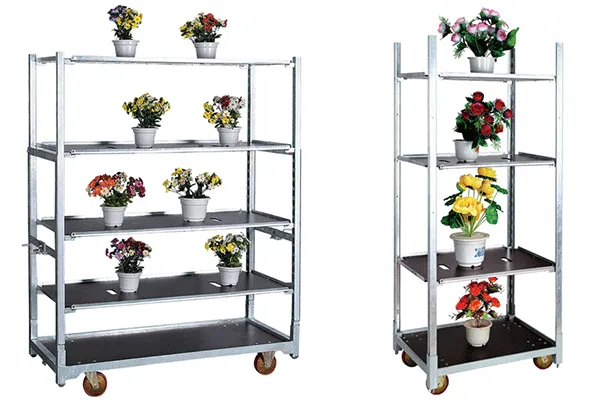
What exactly is a Danish trolley?
A Danish trolley is a modular rolling rack designed for greenhouse and nursery operations. Its hallmark is a 4-post steel frame with adjustable shelves that set at different heights using corner post slots. With swiveling castors, staff can transport plants through narrow paths, trucks, and retail aisles. The system’s uniform footprint means trolleys nest, stack, and cube predictably, reducing freight and labor.
Why horticulture adopted the Danish trolley system
- Space efficiency: Slim footprint maximizes bench density and truck loading patterns.
- Plant safety: Smooth ride and stable shelving reduce damage to flowers and plants.
- Speed: One person can move hundreds of pots with minimal handling.
- Flexibility: From propagation to retail display, the same cart follows the crop.
- Standardization: Sizes align with CC/Dutch logistics pools and auction workflows.
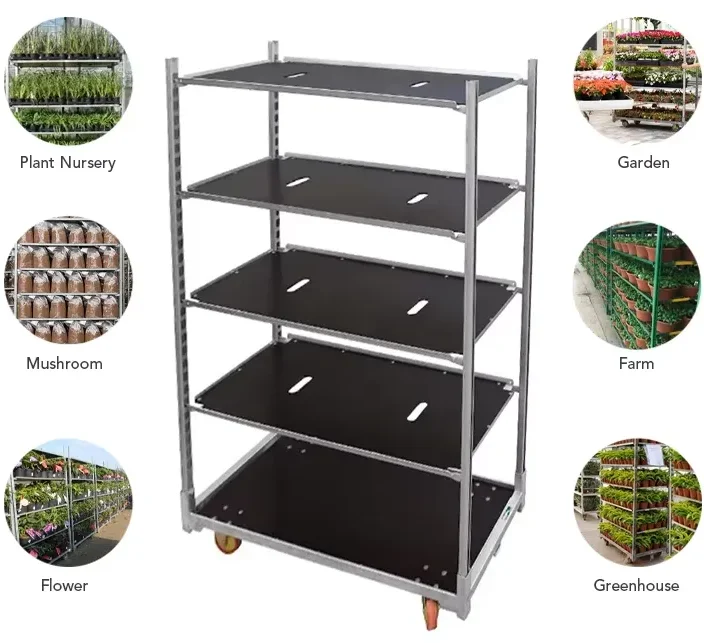
Anatomy of a high-quality Danish trolley
Core components
- Frame: Rectangular steel frame with 4 posts, often hot-dip galvanize or powder coating for corrosion resistance.
- Shelves: Plywood shelves (sealed edges) or wire mesh / metal mesh shelves; height adjustable along posts.
- Castors: Four swivel caster wheels (often two with brakes).
- Accessories: ID plates, shelf stops, strapping points, and corner protectors.
Common shelf materials
- Plywood: Warmer surface for tender foliage; economical and quiet.
- Wire mesh / metal mesh: Wet-room friendly, drains fast, easy to sanitize.
Dimensions, capacity, and configuration options
| Parameter |
Typical Range / Option |
Why it matters |
| Footprint |
CC/Dutch standard base (approx. 1350 × 565 mm) |
Interoperability with CC logistics and auctions |
| Post height |
1350–1900 mm (custom on request) |
Headroom for flowers and plants of different heights |
| Shelves |
3 to 6+ (heights adjustable) |
Match crop stages and pot sizes |
| Shelf types |
Plywood, wire mesh |
Choose for drainage vs. gentler support |
| Wheels |
125–160 mm castor diameter |
Larger wheels roll better over hoses and thresholds |
| Finish |
Galvanize or powder coating |
Environment and corrosion demands |
| Load |
300–500 kg typical (cart + shelves) |
Check weight capacity if hauling heavy containers |
Tip: If you often hose down floors or run misting, go galvanized frame + wire shelves for longevity.
CC container, Dutch compatibility, and interchangeability
Many buyers need compatibility with CC (Container Centralen) pools and Dutch auction flows. Look for:
- Base and post patterns matching CC/Dutch standards.
- Shelf notch spacing that aligns with CC trolley posts.
- Castor plate bolt pattern (easy field replacement).
- Markings or documentation confirming CC/Dutch interoperability.
Plywood vs. wire mesh shelves: which should you choose?
Plywood shelves
- Best for liners, seedlings, and delicate foliage.
- Low noise and good surface friction.
- Seal edges to resist swelling in wet areas.
Wire mesh shelves
- Fast water drainage; superior hygiene.
- Ideal for outdoor garden center canopies and wet corridors.
- Slightly less forgiving for tender leaves—use tray liners if needed.
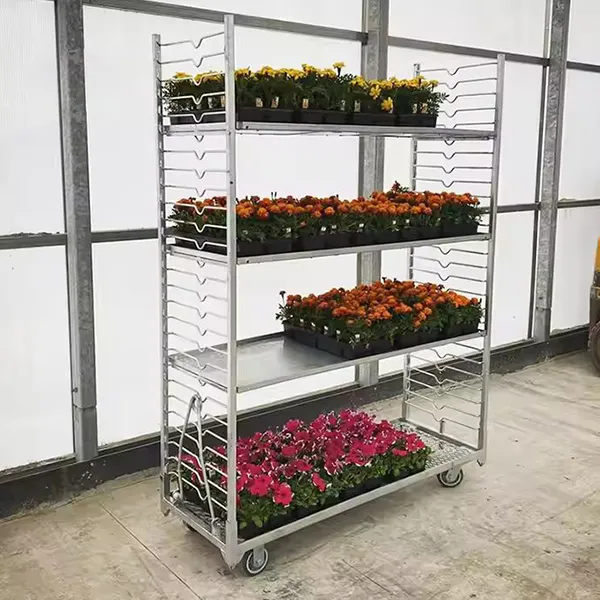
Danish trolley vs. alternatives: quick comparison
| Option |
Strengths |
Trade-offs |
Best use |
| Danish trolley |
Adjustable shelves, tight turning, standard sizes |
Shelf management; slightly higher initial cost |
Crop-to-retail, multi-stage workflows |
| Flatbed cart |
Simple, cheap, open deck |
Stacking fragile pots is risky |
Bulk bags, hard goods |
| Wheelbarrow |
Narrow access, low cost |
Low capacity, manual handling strain |
Spot tasks, DIY |
| Pallet + jack |
High cube per move |
Needs palletization; rough on plants |
Warehouse staging |
| Garden wagon |
Side rails, outdoor traction |
Larger turning radius |
Outdoor retail, gravel paths |
How many trolleys do you need? A back-of-envelope sizing method
- Daily peak moves: Count pots per peak hour × hours.
- Per-trolley capacity: Pots per shelf × number of shelves.
- Cycle time: Load + move + unload + return (minutes).
- Trolleys required:
– Peak pots per hour ÷ (pots per trolley per cycle) × cycle time ÷ 60
Add 10–20% buffer for maintenance and overlap between shifts.
Materials and finishes: choose for your climate and cleaning style
- Hot-dip galvanize: Best for long wet cycles, saline drift, and heavy washdowns.
- Zinc electro-plate: Economical for indoor or light-duty applications.
- Powder coating: Color-coding by department or crop; pair with pre-galvanized steel for corrosion control.
- Stainless options (select parts): For aggressive sanitation protocols.
Mobility matters: wheels, brakes, and maneuverability
- Wheel diameter: 125–160 mm glides over hoses and cracked concrete.
- Tread: Elastic rubber = quiet + grip; polyurethane = durability + ease.
- Brakes: Two braked castors stabilize on slopes.
- Bearing: Precision bearings reduce push forces and operator fatigue.

For tight greenhouse aisles, prioritize maneuverability and easy to move handling over maximum speed.
Buying checklist for growers, nurseries, and garden centers
- Footprint: Matches your benches, doors, and trucks.
- Posts & shelves: Adjustable; confirm notch pitch and shelf count.
- Shelf type: Plywood or wire mesh (or mixed fleets).
- Finish: Galvanize/powder coating based on humidity and washdown.
- Castors: Diameter, tread, cart with wheels brakes, replacement availability.
- Capacity: Verified static and rolling loads; try a sample with your heaviest pots.
- Interoperability: CC/Dutch compatibility if you participate in pools or auctions.
- Spare parts: Posts, shelves, caster kits, corner protectors in stock.
- Warranty & QC: Documented inspection and traceability.
How we build Danish trolleys for durability and lower total cost
As a Danish trolley and garden carts/trolley manufacturer, we engineer for lifecycle value, not just the sticker price.
- Steel selection & forming: High-strength steel frame, tight tolerances for true shelves and silent rolling.
- Surface treatment: Pre-treat, then galvanize or powder coating based on your climate and cleaning SOPs.
- Shelf engineering: Plywood with sealed edges or hygienic wire mesh; shelves are available in custom sizes.
- QC process: Incoming steel checks, weld integrity tests, torque audits on wheels, dimensional inspection on 4 posts and bases.
- Logistics: Nested shipping reduces freight; factory direct programs ensure competitive price and schedule stability.
Company snapshot: 10,000+ m² factory, CNC stamping, welding robots, packaging lines; ISO9001 certified. Annual capacity for carts exceeds 200,000 sets, enabling delivery and supply stability during peak seasons.
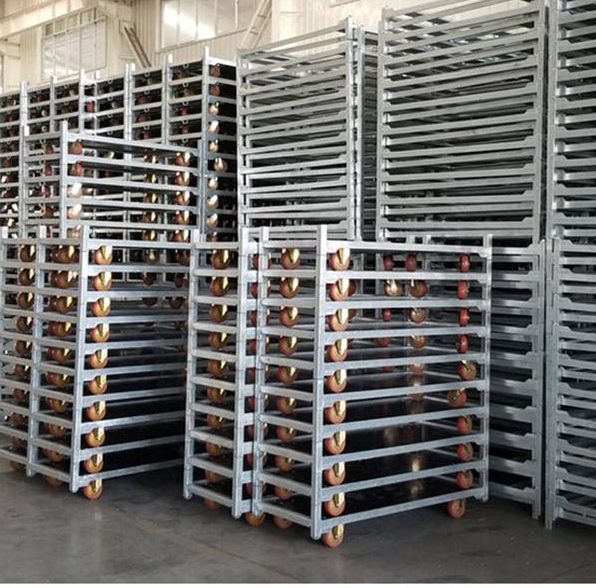
Real-world case: cutting handling time by 32% in a garden center chain
A multi-site garden center used mixed carts and flatbeds. We introduced a unified Danish trolley system with adjustable shelves and 160 mm castors.
Results after 8 weeks:
- −32% handling minutes per pallet equivalent.
- −18% plant damage on delivery days.
- +22% display speed during weekend resets.
- ROI in 5.5 months thanks to labor savings and lower shrink.
Maintenance tips to extend service life
- Daily: Quick wheel spin and brake test; remove debris from axles.
- Weekly: Shelf inspection; re-seal plywood edges if worn.
- Monthly: Check fasteners, post straightness, and caster bolts; swap any noisy wheels.
- Quarterly: Deep clean; verify finish integrity; rotate carts to balance wear.
Frequently asked questions
Is a Danish trolley the same as a CC trolley?
They share the same logistics ecosystem; many Danish bases and posts are CC/Dutch compatible. Always confirm dimensions, post notches, and wheel plates for full interchangeability.
What’s better, plywood or wire mesh shelves?
Choose plywood for delicate foliage and quiet indoor work; choose wire mesh for drainage, sanitation, and outdoor canopies. Mixed fleets are common.
How many shelves do I need?
For liners and 9–12 cm pots, many buyers run 3 shelves plus base. For taller crops, 2–3 shelves with wider spacing prevent leaf rub.
Do you offer customized products?
Yes—customized products include height, shelf count, shelf material, finish, brakes, labels, and color coding. We also match danish container and container trolley specs.
Can these be used beyond horticulture?
Absolutely. Food halls, florists, fulfillment backrooms, and exhibition display teams use them as display cart and transport trolley because they’re stable and easy to transport.
Specification template you can copy into your RFQ
- Base: CC footprint, reinforced corners
- Posts: 1800 mm, notch pitch 50 mm, set of 4
- Shelves: 5 × plywood shelves (or wire mesh), sealed edges
- Castors: 160 mm elastic rubber, 2 braked, bolt plate standard
- Finish: Hot-dip galvanize (option: powder coating RAL color)
- Rated load: 400 kg rolling
- Accessories: Label plate, corner bumpers, strap points
- QA: ISO9001 lot traceability, incoming/outgoing inspection reports
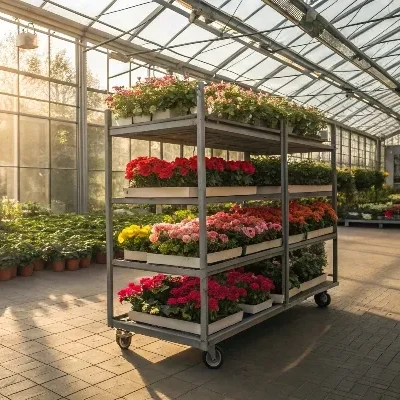
Why partner with a manufacturer (not just a reseller)
- Consistency: Same tooling and fixtures = repeatable quality.
- Lead-time control: Direct capacity planning avoids seasonal stockouts.
- Spare parts: Guaranteed caster, posts, and shelf availability.
- Engineering support: On-site tweaks for greenhouse and nursery workflows.
Ready to specify your fleet?
Tell us your aisle width, crop heights, shelf preference (plywood vs wire mesh), and sanitation regimen. We’ll size the wheels, finish, and shelf count—and ship a pilot fleet you can test on your heaviest weeks. Expect high quality and competitive price, with competitive price from our factory and stable replenishment all season.
Key takeaways
- Danish trolleys are the standard for moving and displaying plants efficiently.
- Focus on compatibility, shelf choice, finish, and wheels for your environment.
- Verify CC/Dutch interchangeability when you ship or buy through pools/auctions.
- A well-specced fleet cuts labor, lowers shrink, and pays back fast.
- Work with a manufacturer for customization, spare parts, and best price lifecycle value.





